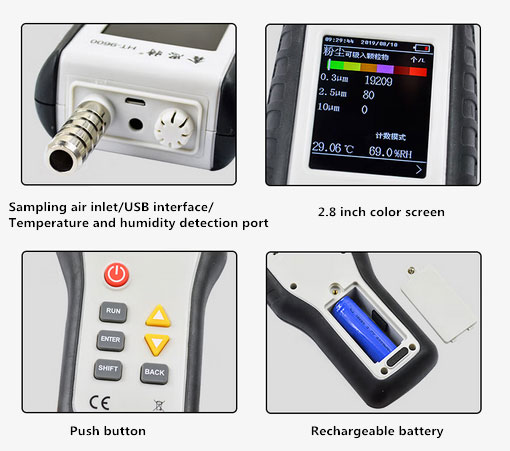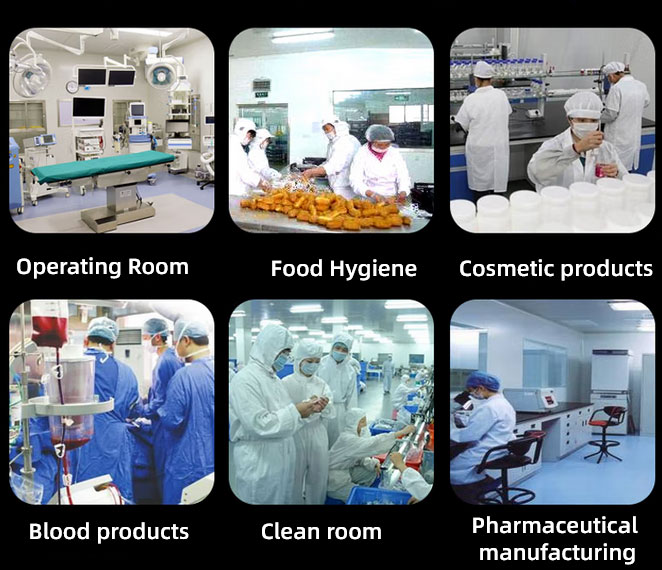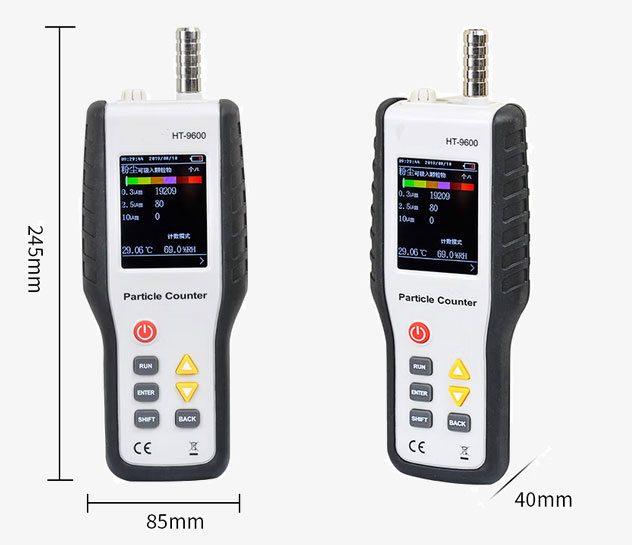Particulate meter for workshop clean room, can store 999 sets of test data, small size, easy to carry, measurement range PM2.5/PM10, applied to clean room inspection, filter field inspection, biosafety cabinet, HVAC system, computer room, food and beverage packaging environmental testing.

The stable light source, strong anti-interference
- Two measurement modes: air quality + temperature and humidity measurement, and dust particles + temperature and humidity measurement.
- LCD value displays 2.8-inch color screen display.
- Data recording function, which can store 999 sets of data.
Application
Handheld dust particle counters are widely used in clean room inspection, filter field inspection, leak detection, monitoring ultra clean benches, biological safety cabinets, HVAC systems, computer rooms, food, beverage packaging environment, pharmaceutical, medical machinery production environment, hospital clean operating room, automotive painting environment, etc.

| Model | SISCO-HT9600 |
| Size Range | PM2.5/PM10 |
| Sensor Principle | Photoelectric type |
| Light Source | Laser diode |
| Particle Size Channel | 0.3um/2 .5um/10um |
| Flow Rate | 1L/min |
| Measuring Range | 0-1000ug/m3 |
| Resolution | 1ug |
| Detection Method | Manual |
| Sampling Time | 50s |
| Sampling Method | Fan constant flow sampling |
| Typical Accuracy | <20% |
| Concentration Unit | Pcs/L ug/m3 |
| Temperature Range | 0~50°C |
| Typical Accuracy | ±1°C |
| Humidity Range | 0~99%RH |
| Typical Accuracy | ±2%RH |
| Operating Environment | -10~50°C 10~90%RH |
| Storage Data | 999 Groups |
| Auto Shutdown | 2 minutes (no button operation) |
| Power Supply | USB direct charging |
| Display Mode | LCD numerical display with color backlight |
| Screen Size | 2.8 inches |
| Screen Resolution | 320x240 |
| Weight | 325g (including battery) |
| Overall Dimension | 245x85x40mm |
Dimension Unit (mm)

Q1: How to use the handheld particle counter?
A1: The particle counter is simple to use, first determine the number of test points according to the area of the clean room and distribute the test points evenly in the clean room, then set the measurement time, measurement unit, flow rate, and other parameters of the particle counter, then put the particle counter on the plane of 1~1.2 meters height from the ground in the middle of the sampling point, and finally start to test the sampling and record the data one by one.
Q2: How to change the printing paper of the particle counter?
A2: Generally, the printing part of the particle counter has a cover, some covers can be lifted directly to cover, lift it to replace the printing paper, and some need to use a screwdriver to unscrew the screw, the specific instructions are also introduced, open the cover to follow the thermal printing paper can be replaced.
Q3: How to read the dust particle counter?
A3: The results of the dust particle counter, generally the left column is the particle diameter, and the right column is the number of particles per cubic meter.
Tips: How to maintain the dust particle counter?
- The dust particle counter is mainly used to test the clean environment of the clean room, when there are loose particles in the measured area, it should be at least 12 inches away from the inlet pipe. In order to avoid the above particles and liquid pollution sensors and pipeline.
- A particle counter with a sensitivity of 0.1 microns should not be used in a clean room of more than 1000 levels without special precautions to avoid damage to the particle counter sensor.
- Do not measure the mixed gas that may produce reaction (such as hydrogen and oxygen). This gas may also generate an explosion in the counter. Measure these gases need to contact the manufacturer for more information.
- Water, solution or other liquids should not enter the sensor through the inlet pipe.
- When sampling, avoid sampling the gas discharged from the counter itself or the gas contaminated by the counter.
- Do not sample compressed air without high-pressure decompression equipment (such as high-pressure diffusers), as all particle counters are designed to operate at atmospheric pressure.
- Do not start the dust particle counter when the inlet pipe is covered or blocked.
- When there is a printer when connecting an external printer, you need to turn off the counter first; when performing printing operations, there must be printing paper on the printer, otherwise, it will damage the print head.
Thank you for buying industrial test and measurement equipment on SISCO.com, all products sold by SISCO and the partner cover a 12 months warranty, effective from the date of receiving the products.
What is covered?
SISCO is responsible for providing free spare parts, and free technical support to assist the customer to repair the defective products until the problem is solved.
What is not covered?
- Product purchased from anyone other than a SISCO store or a SISCO authorized reseller.
- Expendable parts.
- Routine cleaning or normal cosmetic and mechanical wear.
- Damage from misuse, abuse or neglect.
- Damage from use of parts other than SISCO approved.
- Damage from use outside the product’s usage or storage parameters.
- Damage from use of parts not sold by SISCO.
- Damage from modification or incorporation into other products.
- Damage from repair or replacement of warranted parts by a service provider other than a SISCO authorized service provider.
- Damage caused by the application environment not meeting the product usage requirements and the failure to perform preventive maintenance.

